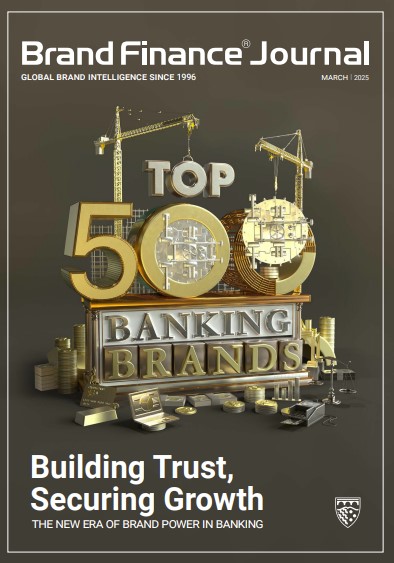This article was originally published in the Brand Finance Banking 500 2025 report

Valuation Director, Brand Finance
Total European brand value in the Banking 500 is 25% higher this year, the fastest growth since 2010, when values bounced back from the lows of the financial crisis. 109 of the 149 European banking brands in the Brand Finance Banking 500 2025 have gained brand value versus 2024.
Value continues to consolidate among the largest banks
Our research finds that among the top 20 most valuable banking brands in Europe, 24% of their market cap is estimated to be the value of their brand. For the other European players, brand represents just 14% of market cap. This reflects the synergies and scale for brand building enjoyed by large banks. This scale effect is increasing in the context the dual challenge European banks face, digital adaption and regulatory change, both of which raise the “you must be this tall to ride” bar.
Deep pocketed incumbents and neobanks are most successfully executing digital innovation initiatives, while smaller, regional banks struggle to keep up. Digital native bank Revolut is the fastest growing banking brand in the world year on year, with 795% brand value growth since 2024, due to strong revenue and customer growth, as well as an upgraded brand strength rating from A+ to AA as the bank makes gains on the back of significant marketing investment and its ‘The Future of Money’ campaign.
Peer neobank brands Monzo and Bunq have newly entered the Banking 500 ranking this year. Our research suggests consumers in Europe no longer base their consideration for their banking brand around whether there are conveniently located branches and ATMs. Rather, consumers seek strong online /digital platforms. Particularly in Western Europe, it is also important for banks to have an easy and smooth customer experience - consumers are time poor and expect everything from their medical support to their bank to be just as easy to deal with as Amazon Prime.
European banks are facing the final implementation of Basel-III, primarily impacting minimum capital requirements and risk exposure, following the 2007 financial crisis. The provisions started to come into force in 2024 and will continue to roll out over the next couple of years. There is a turning of the tide at the core of major European banks, as regional players rush to meet the requirements, and large multinational banks embark on restructurings to remain profitable and competitive. Our analysis and research lead us to believe that we are entering a new era for banks, where brand is one of the core tools banks can leverage to be competitive.
HSBC is the most valuable European banking brand this year, and every year since our study commenced in 2007. Between 2008 – 2010, and again in 2012, HSBC was the most valuable banking brand in the world. Today it stands firm at 11th following a 39% growth in value year on year. The bank has announced a major restructuring to streamline operations and focus on its strongest business lines - HSBC will trim back many of its international retail footprints, leaving just private banking operations in markets such as Mexico. In the anticipation of an interest rate slowdown, banks like HSBC are focusing on fee-based businesses like wealth services and advisory due to its inherent stability and commercial performance versus net-interest margins. Brand strategy makes this move easier, through association with global expertise and track record. HSBC’s international expansion in the 2000s is setting the bank up for success among wealthy clients, even as the company reverses expansion to focus on its core business.
Europe’s 3rd and 4th most valuable banking brands, Barclays (up 29% year on year) and BNP Paribas (up 19% year on year), are also restructuring. Barclays is splitting into five operating divisions, including a separate investment banking unit. Barclays has recently appointed Simon Groves as head of brand, supporting Nina Bibby who was appointed CMO the year prior. Both worked together previously at Virgin Media O2 and are tasked with leveraging and supporting the strength of the Barclays brand through the restructure. BNP Paribas has recently announced its plans to outsource several activities as part of its restructuring, a move which demonstrates that profitability often comes from identifying areas to retreat as well as areas for expansionary growth. As such, BNP aims to remain agile and is reaffirming its position as ‘The Bank for a Changing World.’
Both HSBC and Barclays chief executives are ranked in the top 30 in the Brand Finance Brand Guardianship 100 2025, our annual study into the top performing chief executives. HSBC’s Georges Elhedery ranked 21st and Barclays’ CS Venkat ranked 27th; their strong performance reflective of the surveyed analysts and journalists’ confidence in them as strategists and drivers of change. This year, the drivers of CEO reputation shifted away from the now controversial topic of sustainability, towards leaders who demonstrate they can make big, positive change work. In a dynamic technological and economic environment, leaders of the biggest European banks seem to be doing just that.
The strongest European banking brands are generally focused on a smaller geographic footprint, but their activities demonstrate that a variety in marketing approaches are effective to build trust and brand strength. Note that brand strength reflects global weighted brand strength according to markets of operation.
Romania’s Banca Transilvania is the strongest European banking brand, continuing momentum noted last year as the brand continues to solidify its position as a financial powerhouse in the region. It positions itself as "The Bank for Entrepreneurial People" by emphasizing Romanian roots and identity as a local champion supporting the Romanian entrepreneurial spirit. Our research demonstrates its industry-leading strength in reputation, brand love and premium positioning.
Norway’s Sparebank 1 is the second strongest European banking brand, due largely to its high share of preference in Norway. It has been quick to implement digital tools to enhance customer experience but also performs well on brand love and trust in part due to the bank’s heritage as part of an alliance of regional savings banks. As is perhaps expected of an alliance, Sparebank 1 typically adopts relationship-based marketing initiatives and conducts campaigns via collaborations across the alliance.
Austria’s Erste Bank is the third strongest European banking brand in our study and is perhaps best known for its Christmas advertising campaigns, which have become a firm festive favourite since 2018. These campaigns, in conjunction with refreshed brand identity in 2022 and continued growth in brand strength, reflect the business’s focus on building greater brand presence. The most watched Erste Christmas advertisement from 2018, “What would Christmas be without love?” has over 90m views and demonstrates the power of emotive campaigns to build brand understanding, love and trust.
Banking brands are concerned about technology’s role in accelerating disintermediation in lending and payments, and how banks could become less relevant. However, our research finds that the top driver of consideration across Europe is trust. Transactional services may indeed become disintermediated, as this is more convenient for shoppers in many situations. However, this could present an opportunity for banks to become closer to, not further from, their customers. The less banking brands are seen as facilitating functional essential transactions, and the more they are associated with trustworthy advice, the better, regardless of whether that advice is human or AI-enabled.

